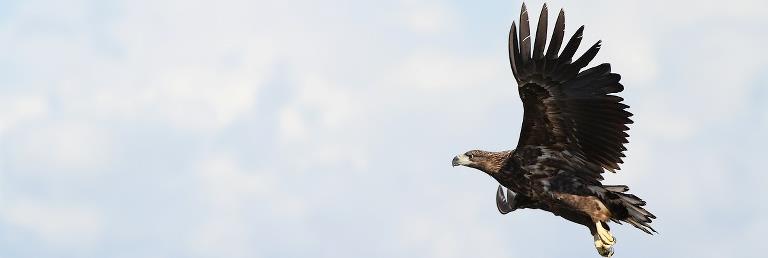Sea eagle
In 1996, the sea eagle returned to Denmark as a permanent breeding bird, after being absent for over 100 years. During this period, a few breeding attempts were made, including at the Maribo Lakes, without any breeding success.

Extinction and return of the sea eagle
During the 1800s, the sea eagle gradually became extinct as a breeding bird in Denmark. At the time, the view of birds of prey and other so-called pests was that they should be completely eradicated, and during the first decades of the twentieth century the sea eagle had also been successfully shot out of existence.
The white-tailed eagle tried to breed in Storskoven at Søholt in 1979 and 1980. However, this was not successful, partly because the accumulation of environmental toxins caused the eggs to become thin-skinned, so that they broke down during incubation.
In later years, it became increasingly common for young sea eagles in particular to use the Maribo lakes as foraging grounds. As the Holstein population grew, it became not uncommon to see mature sea eagles at the lakes. In 1995, a pair built a nest in the forest. But after the female had apparently laid eggs and incubated for a while, the pair suddenly abandoned the breeding attempt.
The sea eagle returns as a breeding bird
In 1996 we finally got the sea eagle back as a successful breeding bird in Denmark. In Southern Jutland, two pairs of sea eagles had chicks on the wing. At Bankel Lake and at Hostrup Lake. This was a good indication that the increase came from the Holstein area. In 1996 there was still a pair at the Maribo lakes, but they did not breed.
Only in 1997 did the pair breed successfully and fledge one chick after building a new nest in the Beech Forest north of Hejrede Lake. The nest was high in a beech tree, so it could be seen from almost 1.5 kilometres away from Sølund between Slemminge and Godsted, east of Hejrede Lake. Here, Storstrøms Amt, in cooperation with DOF, set up an "eagle nest" where the public could gain concrete knowledge about the sea eagle and follow the development of the eaglets directly in the nest with the help of some large telescopes. Unfortunately, the opportunity ended after the 1999 breeding season when the nest tree broke during the December eagle migration of the same year.
New nests
The pair built a new nest close to where the old one had been, but without any possibility for the public to follow the eagles' daily life. In all subsequent years, the eagles have successfully nested in the same place. In 2003, the pair had three chicks on the wing for the first time; otherwise, one or two chicks is normal.
In the autumn and winter of 2005-2006, the eagle pair built a new nest. However, the eagles still chose to build in the same forest area and relatively close to the old nest, so there has been no change in the access rules to Beech Forest. During the juvenile period, the old eagles can often be seen in the forest edge at the eastern end of Bøgeskov.
Public access
The authorities, in cooperation with the landowner, have established a partial closure of public access to the forest area to protect the breeding eagles.
In 2017, a new breeding pair established itself in the forest on the Dornæs-Romsø peninsula, which almost divides the large Søndersø lake into two large basins. The new pair managed to fledge a chick in their first breeding season.
